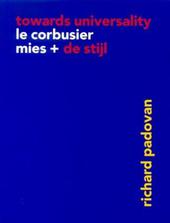
|
Towards Universality: Le Corbusier, Mies and De Stijl
Paperback / softback
Main Details
| Title |
Towards Universality: Le Corbusier, Mies and De Stijl
|
| Authors and Contributors |
By (author) Richard Padovan
|
| Physical Properties |
| Format:Paperback / softback | | Pages:256 | | Dimensions(mm): Height 248,Width 191 |
|
| Category/Genre | Theory of architecture
Individual architects and architectural firms |
|---|
| ISBN/Barcode |
9780419240303
|
| Classifications | Dewey:720.922 |
|---|
| Audience | | Postgraduate, Research & Scholarly | | Undergraduate | |
|---|
| Illustrations |
129 Line drawings, black and white
|
|
Publishing Details |
| Publisher |
Taylor & Francis Ltd
|
| Imprint |
Spon Press
|
| Publication Date |
13 December 2001 |
| Publication Country |
United Kingdom
|
Description
There is no shortage of books about Le Corbusier, or Mies van der Rohe, or De Stijl. This one is different, however, in a number of ways. First, it does not treat them as separate subjects, but in relation to each other. While their response to De Stijl throws some new light on Le Corbusier and Mies, it is above all De Stijl that can be more sharply defined in relation to them. Second, the purpose of the study is to excavate the philosophical foundations of the work, rather than merely to describe and discuss the work itself. Third, it looks for connections between the aims and ideals of the 1920s and such 'post-modern' concerns as the creation of habitable 'places' and the survival of the historical city. The book's central theme is the striving for universality as opposed to the individual and the particular. The foundation manifesto of De Stijl begins: 'There exists an old and new consciousness of the age. The old is directed towards the individual. The new is directed towards the universal' (1918). This first opposition is intersected, however, by a second one: that between the open and the closed. The universality aimed at by De Stijl artists like Van Doesburg and Mondrian resembled that of the universe itself: it was boundless. Their paintings continued, in theory, beyond the limits of the canvas; their architecture sought to abolish the wall as the boundary between interior and exterior space. But each of Le Corbusier's buildings and paintings was itself a self-contained universe, held within a clear frame. Mies fluctuated between the two ideals; in the 1920s, in such designs as the brick country house and the Barcelona Pavilion, he outdid even the De Stijl architects in openness, but in his later work in America he reverted to the closed neo-classical box.
Author Biography
Richard Padovan lectures at the University of Bath. He has worked as an architect in various European countries.
Reviews'Padovan is crystal clear - this book is a little classic.' The Architects Journal
|